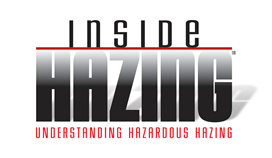WHAT: The Basics
What is hazing?
Hazing is a process, based on a tradition that is used by groups to discipline and to maintain a hierarchy (i.e., a pecking order). Regardless of consent, the rituals require individuals to engage in activities that are physically and psychologically stressful.
These activities can be humiliating, demeaning, intimidating, and exhausting, all of which results in physical and/or emotional discomfort. Hazing is about group dynamics and proving one's worthiness to become a member of the specific group.
What is hazardous hazing?
Hazardous hazing occurs when the traditions or initiation rites skid out of control and cause significant and lasting physical and/or psychological damage. When hazardous hazing occurs everyone in the group, including the perpetrators, (those who planned and carried out the actions) bystanders (those who watched and did not actively participate) and victims, (those who were receiving the hazing) may be psychologically traumatized.
The families of those involved, coaches and other supervisors may also be traumatized; even if they were not present during the hazardous hazing.
Their trauma may be evident immediately, it may be delayed for months or years or even decades.
What is bullying?
Bullying is an intentional act of aggression that is meant to harm a victim either physically or psychologically. Bullies usually operate alone or in small groups and choose to victimize individuals who they perceive as vulnerable. Victims attract bullies by their small stature, their younger age, or lower social status. Frequently there is only one specific victim who is often a scapegoat.
There are no traditions involved, nor are there authority figures or leaders.
The intent of the bully is to satisfy his own personal needs, such as obtaining money, lunch, homework or simply intimidating someone. Bullying has been observed in preschool children whereas hazing does not begin until middle or high school.
What is the difference between hazing and bullying?
Hazing is a group activity, that is planned, and has a beginning, middle and end. No individual gains anything, other than being accepted into the group. Bullying is typically a spontaneous activity that garners the bully an object such as lunch, homework, money, or social status.
Bullies frequently target an individual whereas hazing typically targets groups of people.
What is the blueprint of hazing?
The blueprint of hazing states that the newcomer, or victim, is hazed. Once accepted by the group, the victim becomes a bystander, and watches as others get hazed. Eventually, the bystander achieves senior status and power, and becomes a perpetrator.
Perpetrators do onto others what was done to themselves and they feel as though they have the right and duty to pass on the tradition. High school students pack up this blueprint and stuff it into their backpack, in order to take their hazing experience with them to college, the military and the workplace. Each hazing brings with it the possibility of a new twist. Perpetrators want to leave their mark on the tradition, and therefore they may add or change the tradition, slightly, often increasing the severity of the ritual. For example, more alcohol is required to be ingested; paddling may become more intense, or sexual acts may be more violent.

WHO: The Characters
Perpetrators
The people who have power and control and use it to cause discomfort, physically or psychologically. They are directly involved and are held responsible for the consequences of a hazing.
Bystanders
Those who are observing but not actively participating in the actions taken by the perpetrators. Bystanders, as a group, have the power to increase or decrease the degree of aggression perpetrated against victims. Bystanders are effected by and responsible for hazings.
Alumni
People who “graduated” from the group, often return to be involved in the hazing. Despite the fact that alumni are older than the current members, they often encourage hazing rituals to be repeated, and sometimes with more vigor than current members intended. Alumni have been known to brag: “back in my day, the hazing was worse.”
Supervisors
Those who are supposed to be supervising the activities of the group. These people have been given responsibility by an authority to be "in charge.” Coaches are an example of supervisors who are often held responsible for hazing on athletic teams.
Administration
The higher authority that is responsible for choosing the supervisors and for allowing the group to exist. These people are typically considered legally responsible even if they knew nothing about the event. For example, in fraternity hazing lawsuits the national as well as local chapter are assumed to be responsible for the hazing activities.
Community
The larger group, such as a town, in which the hazing has occurred. The community also has a responsibility to demand appropriate controls from the administration.
WHERE does hazing happen?
Hazing may occur anywhere. Often it is in locker rooms, on sports fields, on a school bus, or in any area that is large enough to accommodate the group. Frequently the location is part of the tradition, and it re-occurs at the same place. Hazing may occur on or off campus. Usually the participants perceive a lack of adult supervision. They do not believe that outsiders or authorities will intervene to stop the activities. It seems that, for the most part, the greater community is reluctant to report a hazing or to stop hazing, and therefore, hazing continues, often in broad daylight.
WHEN: The Timing
Hazing occurs throughout the year. Each season begins another sport, and with it the traditional rites of passage which may include hazing. This is true for both men's and women's teams. Often the beginning of the school year, late August and early September, mark hazings that occur against freshmen in high school and college. Fraternities and sororities begin to recruit new members in the fall, around August/September and in the winter, around January/February. Hazings associated with pledge activities usually follow "rush week" and culminate 4-12 weeks later, in "hell week." This is the most dangerous time, since the hazing activities are continuous and intense. Hazing in the military and on the job occurs at any time throughout the year, with special events (i.e. crossing the equator in the Navy) occurring at times that are traditional to the specific group.





